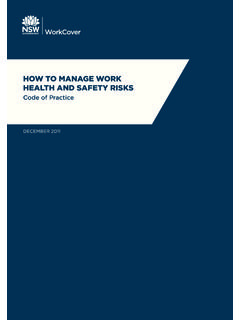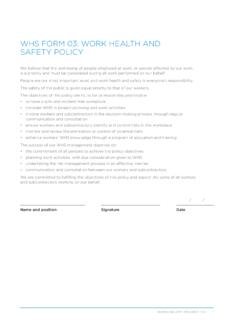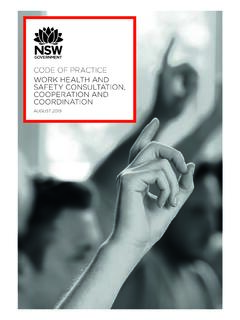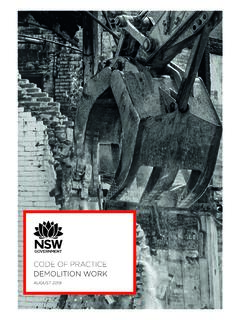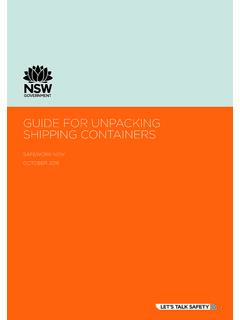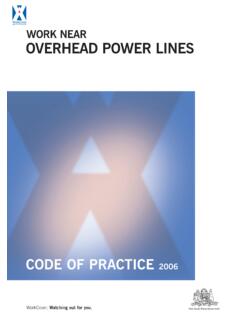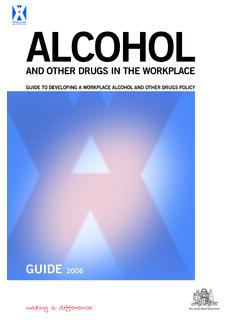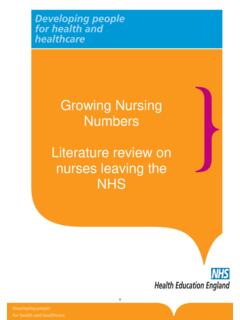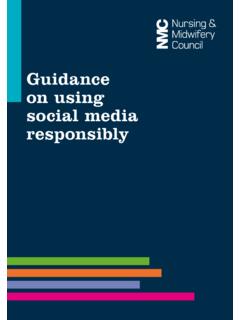Transcription of Cytotoxic drugs and related waste – risk management
1 Cytotoxic drugs AND related waste RISK MANAGEMENTJ U LY 2 0 1 7 DisclaimerThis publication may contain information about the regulation and enforcement of work health and safety in NSW. It may include some of your obligations under some of the legislation that SafeWork NSW administers. To ensure you comply with your legal obligations you must refer to the appropriate on the latest laws can be checked by visiting the NSW legislation website publication does not represent a comprehensive statement of the law as it applies to particular problems or to individuals or as a substitute for legal advice. You should seek independent legal advice if you need assistance on the application of the law to your material may be displayed, printed and reproduced without amendment for personal, in-house or non-commercial No.
2 SW08559 SafeWork NSW, 92 100 Donnison Street, Gosford, NSW 2250 Locked Bag 2906, Lisarow, NSW 2252 | Customer Experience 13 10 50 Website Copyright SafeWork NSW 0917 ACKNOWLEDGEMENTSThis guide was prepared by the Cytotoxic drugs working party and first published in 2008. It provides a practical health and safety standard for the health care industry in workplaces where Cytotoxic drugs and related waste are of the working party represented a range of stakeholders and health care practitioners who are dedicated to improving health and safety in the health care industry. Without their participation, this project would not have been possible. Members of the original working party were:WorkCover NSWDr Usha St George Mr Ted Szafraniec Dr Bhoopathy SankaranNew South wales Nurses AssociationMs Trish Butrej Ms Mary McLeodCancer Nurses Society of Australia SydneyMs Vivienne FreemanHealth Services UnionMr Mark HanlonClinical Oncology Society of Australia (COSA)Prof Bernard W StewartSociety of Hospital Pharmacists of AustraliaMs Johneen TierneyNSW HealthMs Frances Waters Ms Lyndall DavisIn addition to working party members, various other health care industry groups and individuals had provided their input.
3 Their assistance is highly 2016, this guide was updated for the requirements of current Work Health and Safety Regulation 2011 (WHS Regulation) by Dr Bhoopathy Sankaran and Dr Vivian Fung of SafeWork NSW and was circulated to members of the 2008 Cytotoxic drugs working party. Their generous feedback in updating this guide is greatly also thank the Ministry of Health (Workplace Relations Unit) for providing comments on the revised Guide and especially Angie Stanojevic Senior Policy Advisor; Dr Ian Cheng Occupational Physician, Royal North Shore Hospital and Leslie Gibbs Professional Officer, NSW Nurses and midwives Association, Australian Nursing and Midwifery Federation, NSW following publications provided invaluable reference during the preparation of this guide: Handling Cytotoxic drugs in the workplace, January 2003, WorkSafe Victoria Guide for handling Cytotoxic (anti neoplastic) drugs and related waste , 2005, Queensland Department of Industrial Relations Guidelines for handling Cytotoxic drugs and related waste in health care establishments, 2nd edition, 1995, WorkCover guide is neither definitive nor set in concrete.
4 Practices change over time and comments on how this document can be improved are welcome. Please contact SafeWork Freeman and the Royal North Shore Hospital are gratefully acknowledged for the provision of the forms and instructions relating to the Cytotoxic drug precautions alert in Appendix 11 and Your continuous infusion device pump and Chemotherapy spill at home in Appendix Introduction Purpose Scope What are Cytotoxic drugs ? Potential adverse health effects Risk control 112. Legislative requirements Work Health and Safety Act 2011 Work Health and Safety Regulation 2011 Managing risks Hazardous chemicals Duties of manufacturers.
5 Importers and suppliers of hazardous chemicals Labelling Safety Data Sheets Duty of supplier supplying carcinogenic chemicals Summary of duties of PCBUs who use hazardous chemicals Plant and equipment Other NSW legislation and standards Integrating health and safety into the workplace The risk management approach Consultation 193. Managing risks to health and safety Identify hazards of Cytotoxic drugs used and stored at the workplace Assess the risks Record, review and revise the risk assessment Control the risk Hierarchy of control Eliminate the risk Personal protective equipment Make the workplace safer Develop a risk control plan Maintain risk controls Review control measures 294.
6 Personnel management General What is health monitoring? Biological monitoring What type of health monitoring should be provided? Planning parenthood, pregnancy and lactation Emergency procedures Reporting and keeping records 345. Information, instruction and training Who should be trained? Identify what information and training is needed Evaluate the training program Keep training records 366. Preparing and dispensing Cytotoxic drugs Control measures Alternative supply arrangements Setting up a Cytotoxic drug preparation facility drug preparation facilities Work organisation layout and design drug storage drug preparation equipment Standard operating procedures for preparing Cytotoxic drugs Parenteral preparations Non-parenteral preparations (extemporaneous)
7 Labelling Personal protective equipment Packaging and transporting Cytotoxic drugs drug packaging drug transport inside and outside the hospital Maintaining controls Performance testing and inspection of facilities and equipment Equipment maintenance Cleaning drug preparation facilities Summary of control measures 427. Administering Cytotoxic drugs Key risk control measures Setting up a drug administration area Cytotoxic drug administration Equipment Parenteral administration Topical agents Oral administration Summary of control measures 458.
8 Managing Cytotoxic contaminated body wastes Key risk control measures Assessment of body waste contamination Procedures The patient care area Patient care equipment Standard operating procedures Personal protective equipment Transporting patients Within an establishment By ambulance Laundering Personal protective equipment Linen Summary of control measures 499. Spill management Sources of spills Spill management strategy Training Spill kit contents Spill containment In health care settings In community care settings On carpets Within a Cytotoxic drug safety cabinet or cleanroom Contamination Clothing and personal protective equipment Penetrating injuries, skin and other body contact Mucosal exposure Reporting procedures Notification of incidents Summary of control measures 5310.
9 waste management What is Cytotoxic waste ? Risk management Control measures Identification, containment and segregation Labelling requirements Containment Segregation Licences for the generation and storage of Cytotoxic waste Requirements for handling or storage of Cytotoxic waste Internal movement of Cytotoxic waste waste storage Off-site transport Licences to transport Vehicle signage Other requirements for Cytotoxic waste transportation waste disposal and treatment Thermal destruction Stockpiling Cytotoxic waste Record-keeping requirements Summary of control measures 6111.
10 Caring patients in community settings Doctor s surgery and ambulatory care facilities Managing risks Personnel management Information, instruction and training Preparing and dispensing Cytotoxic drugs Administering Cytotoxic drugs Managing Cytotoxic contaminated body waste Spill management Caring for patients at home Role of the treating facility Setting up a patient care area drug transport Maintaining controls Equipment Administering Cytotoxic drug Managing Cytotoxic contaminated body waste waste management Home laundering Standard operating procedures Emergency procedures Summary of control measures 6612. Cytotoxic drugs in veterinary practices Information.
